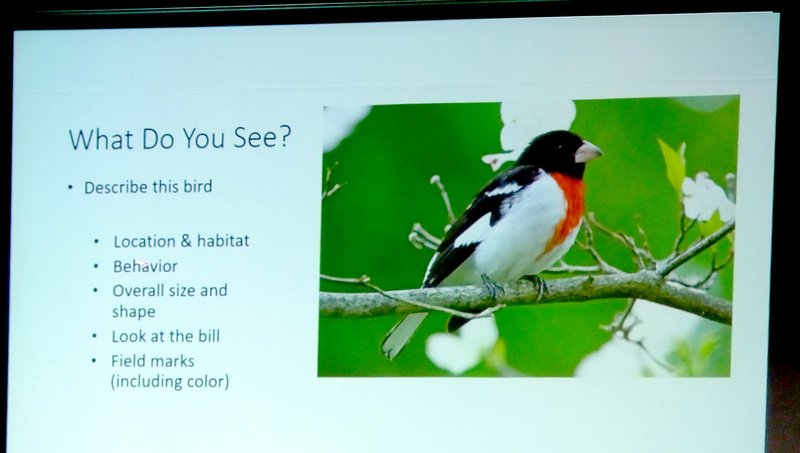BELLA VISTA -- The first mistake novice birders make is to spend too much time looking in their guides, Butch Tetzlaff of the Bluebird Shed told a group gathered to hear his bird ID seminar at Concordia on Saturday, Feb. 16. Instead, they should be looking at the bird and noting identifiers. Later, when the bird is gone, they can look it up in the guide.
People usually want to identify a bird by color, but there are other ways to ID a bird. Colors can be tricky because few birds have only one color. Another problem is that the color of a bird can vary for several reasons. For example, a female Cardinal is not the same color as the male. Birds can also change color at different stages in their lives and during different seasons.
Some things are less likely to change, like the habitat where the bird is found. There's no point looking in a guide for a bird that isn't native to the area. There are 10,000 different birds in the world, he said, but only 250 are found in Benton County.
Even in the county, habitat will vary. Some birds prefer to be on the ground, while others perch on a branch.
"You're never going to find a duck in the forest," he said.
Another clue to identify a bird is behavior. Is it soaring? Is it clinging to a tree trunk?
Size and shape are also identifiers.
In this area, if you see a yellow bird, it's a goldfinch, Tetzlaff said. A goldfinch is bright yellow in the summer but darker in the winter.
If you see an orange bird, it's probably an oriole, but orioles are only in the area for a few weeks in April and early May. Orchard orioles are a rusty color compared to Baltimore orioles. All orioles like grape jelly, he said.
There are several species of blue-colored birds. An eastern bluebird has a red belly, while a blue jay has a white breast. An indigo bunting is almost all blue.
A bird that lands on a feeder, takes one seed and flies off to eat it is probably either a Carolina chickadee or a tufted titmouse.
A bird that clings to the trunk of a tree and moves down the tree face first is probably a nuthatch. A brown creeper clings to the trunk buy moves up the tree.
Tetzlaff said there are seven types of woodpeckers in the area, and all of them have some red on their heads. The large pileated woodpecker is the most common. Redheaded woodpeckers are becoming rare and ivory-billed woodpeckers are probably extinct.
Tetzlaff has his own term for brown birds. "LBJ" stands for little brown job. There are so many varieties that he recommends looking for their grouping: wrens, sparrows or finches.
"Birds of Arkansas" is a good guide, he said, but he recommends people don't stop with one guide. He owns about 35. When you buy a guide, make sure it's easy to read. While pictures can be helpful, often the written descriptions of a bird are the best way to identify them.
Even very experienced birders can have a hard time identifying some birds. But that's all right, he said, not every bird needs to be identified.
General News on 02/27/2019
